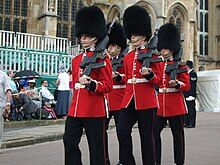Scots Guards

Scots Guards ( German Scottish Guard ) is the name of a regiment of the Guards Division (Gardedivision) of the British Army . It is one of the five body regiments of Queen Elizabeth II.
history
The Scots Guards are the third oldest of the British Army's foot guards regiments. The regiment traces its origins back to the year 1642, although it was renamed several times. The current name was given by Queen Victoria in 1877 . As the third oldest footguard regiment, it can be recognized by the fact that the buttons on the parade uniforms are arranged in groups of three. The motto of the regiment corresponds to that of the Scottish thistle order : Nemo Me Impune Lacessit = Nobody irritates me with impunity.
Scots Guards soldiers fought in all major wars of the British Empire during the 18th and 19th centuries . During the two world wars, the regiment's battalions were deployed on almost all fronts in Europe and North Africa where British troops fought. After the Second World War, the regiment took part in the Falklands War , but also in many operations within the framework of UN peace missions. It was also used in the Persian Gulf .
A common soldier in the Scots Guards is called a Guardsman (while in regular units he is called Private ), an award introduced by King George V after the First World War .
Today the regiment's first battalion serves as mechanized infantry . A special company , which continues the tradition of the second battalion, is used as a guard unit . The regiment regularly participates in many important protocol events in Britain, such as B. Trooping the Color and Remembrance Sunday .
The current Colonel of Honor of the regiment is the Duke of Kent, Prince Edward , a cousin of Queen Elizabeth II.
Battle Honors
The regiment has a comparatively long list of battle honors (honorable mentions of battles in which it has participated), some of which are listed on the regimental flag.
Battle honors (English terms)
- before the First World War: Namur , Dettingen , Lincelles, Egypt, Talavera , Barrosa , Fuentes d'Onor , Salamanca , Nive, Peninsula , Waterloo , Alma , Inkerman , Sevastopol , Tel-er-Kebir , Egypt 1882 , Suakin 1885 , Modder River , South Africa 1899-1902
- First World War : Retreat from Mons, Marne 1914, Aisne 1914 , Ypres 1914, 1917, Langemarck 1914 , Gheluvelt, Nun Bosschen, Givenchy 1914, Neuve-Chapelle , Aubers, Festubert 1915, Loos , Somme 1916 , 1918. Flers Courcelette, Morval, Pilckem, Poelcapelle, Cambrai 1917 1918, St. Quentin , Albert 1918, Bapaume 1918, Arras 1918, Drocourt-Quéant, Hindenburg Line, Havrincourt, Canal du Nord, Selle, Sambre, France and Flanders 1914-18
-
Second World War :
- North-West Europe: Stien, Norway 1940, Quarry Hill, Estry, Venlo Pocket, Rhineland, Reichswald, Kleve, Moyland, Hochwald , Rhine, Lingen, Uelzen, North-West Europe 1944–45
- North Africa: Halfaya 1941, Sidi Suleiman, Tobruk 1941, Gazala, Knightsbridge, Defense of Alamein Line, Medenine, Tadjera Khir, Medjez Plain, Grich el Oued, Djebel Bou Aoukaz 1943 I, North Africa 1941–43,
- Italy: Salerno, Battipaglia, Volturno Crossing, Roccheta e Croce, Monte Camino, Campoleone, Carroceto, Trasimene Line, Advance to Florence, Monte San Michele, Catarelto Ridge, Argenta Gap, Italy 1943–45
- Post-war period: Mount Tumbledown, Falkland Islands 1982, Gulf 1991
Identification mark
The various regiments can not be distinguished on foot from a distance . However, they can be recognized by certain details.
- The Scots Guards do not wear a feather on their bearskin hat .
- They wear the thistle , the traditional symbol of Scotland, on their collars .
- Eight buttons divided into 3, followed by a pause and then 2 (from above: 3,0,3,0,2) are located above the belt.
- The soldiers wear a checkered ribbon in red, white and blue on the hat of their normal service uniform.
See also
literature
- Loraine F. Petre, Wilfrid Ewart and Maj-Gen Sir Cecil Lowther: Scots Guards in the Great War 1914–1918. London: John Murray, 1925
- David Erskine: Scots Guards 1919–1955. London: W. Clowes, 1956
- Murray Naylor: Among friends: the Scots Guards, 1956-1993. London: Leo Cooper, 1995

